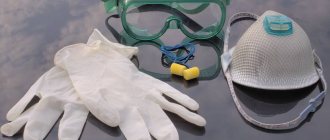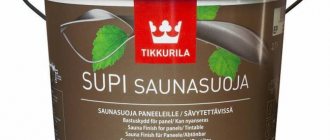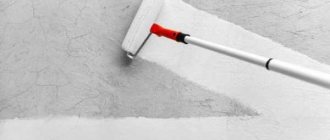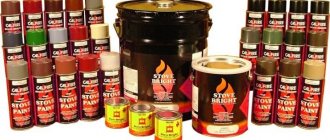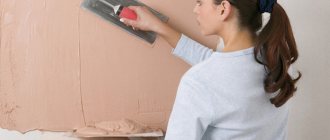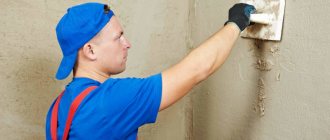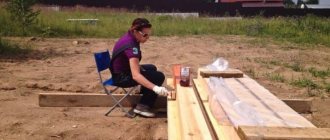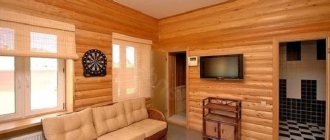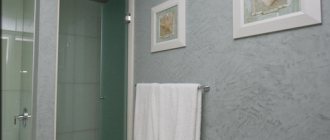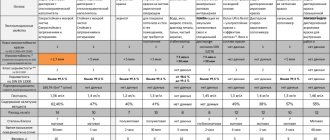The issue of purchasing an antifungal mixture is raised by consumers and customers of residential renovations only when there is obvious mold damage. At the same time, antifungal treatment of walls is desirable in 90% of cases for prevention in new homes, and in 100% of cases in the secondary sector. This is due to the peculiarities of mold getting into apartments and growing. Fungi are in the air, but settle and begin to multiply only under certain conditions - warmth and humidity. These parameters are typical for premises, and the appearance of mold under the right conditions is a matter of time.
Treating walls with an anti-bending mixture is useful in 90% of cases
Antifungal primer - purpose, properties and application
Manufacturers offer a wide range of anti-fungal products, but each product has its own parameters. Please note that only professional options are designed for deep sanitation of surfaces and complete removal of mold. The bulk of proposals provide only effective prevention. Antifungal primer for walls is usually applied after the damaged plaster has been completely removed from the load-bearing surface of the building. This is done with the aim of creating a barrier between the masonry and a new layer of plaster - preferably cement-lime.
Building mixtures are usually not designed for reuse. Only clay damaged by fungus can be used repeatedly, provided that a solution made with the addition of lime is applied. Lime and clay help get rid of the problem. If plaster is applied to the wooden base of an adobe, frame or timber house, it is recommended to pre-paint the surfaces with a self-prepared sanitizing liquid based on copper sulfate.
Manufacturers offer many different anti-fungal mixtures
All antifungal agents contain fungicides and a base that creates a barrier (acrylic, mineral, alkyd, latex, etc.). For effectiveness, a disinfectant composition is used, providing both antibacterial and antiseptic protection. The difference between antiseptics and fungicides is that the former provide short-term sanitation, the latter – long-term. The anti-mold properties of a liquid coating depend on the amount of certain substances that act against fungus and their penetrating ability.
Depending on the purposes and substances used to prepare the antifungal primer, the purpose, properties and application may vary. For example, some products are used as a surface treatment for areas affected by mold, while others create a strong protection for a new coat of plaster. Depending on the base used, concrete, brick, polystyrene bases, fine-porous and large-porous materials can be processed.
Choose products based on the characteristics of the affected area
Removing stains
A simple technique is used to remove stains; removing a dark stain on a wall or ceiling will be easier if it has appeared recently. If external causes have led to the appearance of stains, it is necessary to deal with such a stain in a radical way. To completely eliminate a stain, you need to not only know the reason for its appearance, but also take into account the type of coating. Stains can be removed from drywall using the following tools and solutions:
- Metal spatula and roller;
- acrylic type primer;
- gloves and container for paint;
- laundry bleach or chlorinated solution;
- paint brush and paint.
If the sheet goes in waves, partially collapses or crumbles, it is best to dismantle the drywall and replace it with a new one.
Stains, like fungus, are removed from the surface using a metal spatula. The top layer of finishing material is removed. After eliminating the stain or fungus, it is necessary to treat the surface with a chlorinated compound, allow the surface to dry and apply a primer. After the primer, paint is applied.
Grease stains and traces of drinks can be removed using ammonia; it is applied to a sponge and applied to the damaged surface. After waiting for 20-30 seconds, remove the sponge and repeat the procedure if necessary. You can get rid of stains and fungus using special compounds that are sold in repair stores.
Entrenched contaminants should be dealt with using a different method: the contaminated surface is completely cleaned down to a layer of plaster or drywall. The surface is treated with a degreasing compound and sanded. The damaged surface is primed, allowed to dry for up to a day, and then a new coat of paint is applied. Detergent compositions and sprays for cleaning surfaces are used as a degreaser.
Types of primers against fungus by purpose
Differentiating anti-mold products by purpose helps manufacturers offer products by category. At the same time, the needs of customers and the characteristics of the work they need to perform are taken into account. The purpose implies different concentrations of anti-mold components. The basis also differs, depending on the type of work that was carried out or will be carried out “before” and “after” application.
On sale you can find sanitizing liquids used at the time of major or cosmetic repairs:
- emulsions - to create a protective sanitizing layer between the possibly affected surface and a new layer of finishing;
- con from fungus;
- primer mixtures - for preventive treatment.
The anti-fungal primer is selected based on the work to be done.
The most popular products are the following: Ferozit (mineral-based), MilKill (latex-based), “Acryl Grundierung” (acrylic-based) from the German TM Olympic. In this case, when choosing, you need to pay attention to:
- on the depth of penetration and effect - depending on the nature of the fungal infection;
- based on the materials used to ensure maximum adhesion.
Most bases fit together without any problems. However, when using only latex or acrylic products, performance is greatly improved. Various antibacterial additives help solve the mold problem in the long term.
To combat severe mold damage, specialized and professional concentrates are used. The following are considered the most popular remedies for fungus.
- CT99 brand Ceresit is a concentrate for fungicidal sanitization of premises, used for treating foundations and vertical surfaces. Provides a long-lasting effect, and if the technology is followed, it allows you to completely get rid of the problem.
- Olymp Stop Mold for express treatment without the need to remove the layer affected by the fungus.
- NEOMID BIO spray concentrate for scanning small areas or for preventing areas that have become wet.
- FONGIFLUID ALPA is an active fungicide for all types of surfaces without causing damage. Can be used indoors and outdoors. Available in volumes for construction treatment and in the form of a spray for household use.
- BIOCIDE is a very powerful German product; double painting ensures complete destruction of mold and fungi.
- DALI antiseptic for all types of surfaces, including wood and drywall.
The selection of anti-fungal concentrates and mortars is usually made based on product availability, cost, nature of treatment, and intended purpose.
The Stop-Mold mixture is used for express treatment of the affected area
Effective folk remedies and methods for removing mold from any surfaces
- Household bleach (“whiteness”). These cleaners contain sodium hypochlorite, which effectively kills molds. A negative point in use is that chlorine gradually corrodes wood or concrete, so the finishing decorative layers will also become unusable. In addition, bleach destroys fungus only on the surface of the material, without killing it inside;
- Household (food grade) vinegar solution. Any acid effectively destroys fungal bacteria and mold. The application is quite simple but effective: you need to spray or apply the solution to the surface with a sponge. Ventilation must be provided during operation. After 60 minutes, rinse the surface with clean water, ventilate the room until the smell of vinegar is eliminated;
- Hydrogen peroxide (H2O2) is an excellent antifungal and disinfectant. When spraying a 3% composition onto any surface, microorganisms are completely destroyed. Disadvantage - the composition can bleach the decorative layer;
- Soda (NaHCO₃) is diluted with ordinary water in a ratio of 15:1000. Soda dissolved in water is sprayed (sprayed) onto the wall, and after 60 minutes the wall is wiped with a dry cloth. If there is solution left on the wall after drying, it is not necessary to wash off or wipe it off.
How to remove mold using traditional methods
To achieve the maximum effect when removing mold and fungal diseases of building materials, it is necessary to identify and eliminate the cause, select an antiseptic and carry out preventive work to prevent the re-development of mold. The choice of antifungal primer depends on the surface material, operating parameters and purpose of the structure.
Types of primers by composition
By the name of the above fungal concentrates, you can determine some of the substances included in the composition. As a rule, concentrates are based on a composition of fungicidal preparations. The exception is biocide. Literally the name translates as “destruction of life”, this refers to microorganisms. For humans, natural or synthetic biocide is harmless in acceptable doses. It is also used for pharmaceutical purposes to impart nonspecific antibacterial properties to drugs, and as a preservative in the food industry.
In a broad sense, biocides include pesticides (pesticides), including fungicides to suppress fungi (Bordeaux mixture, formaldehyde) and herbicides (to suppress vegetation, lichens), antiseptics and antibiotics. German antifungal concentrate Biocide is a patented complex formula.
You need to carefully choose an anti-fungal primer
Ready-made primer liquid coatings may differ in composition:
- depending on the chosen basis, this was discussed above;
- universal mixtures that provide protection against all types of potential infections;
- mixtures of targeted action based on one of the drugs.
For professional treatment, specialized fungicides are produced that are used for direct application or production of sanitizing liquid. Effective available methods include veterinary Butox and analogues, copper sulfate (100 g per 10 liters), chlorine bleach “Belizna” (pure or 1:10 aqueous solution). For prevention, sodium is also used (1 tablespoon of soda, 200 g of water, 2.5 liters of washing powder with phosphates), utility rooms are whitened with lime.
The best finished product, according to reviews, is the affordable FONGIFLUID ALPA. Please note that it does not create a film, that is, it is not a specific construction anti-fungal primer. Antifungal liquid is applied before the deep penetration primer layer. You can also prepare your own priming liquid by adding a ready-made solution of Schimmelstopp Dufa, as well as an agricultural fungicide or veterinary pesticide. This could be, for example, Glutex, Absolucid, antifungal Bitsin and others.
The analysis describes several of the most effective antifungal products for walls and provides a comparative overview of the best options available in stores. In particular, the proposed products can be used for self-production of mortars.
The best finished product, according to reviews, is the affordable FONGIFLUID ALPA
Manufacturers
The following primers are in greatest demand in the modern building materials market.
"Mill kill" The solution penetrates deeply into the surface, up to almost 3 cm. It can be used to strengthen loose and poorly adherent surfaces.
The manufacturer recommends applying it in several layers, preferably 2-3 layers. Suitable for rooms with high humidity.
Elegant 296 is an insulating primer. It prevents moisture from penetrating the substrate. Suitable for all types of surfaces. Also covers black to white well. This solution contains a film-forming substance that slows down the absorption of water from the soil.
"Areal-Primer" is an acrylic primer. It contains various types of fungicides that destroy bacteria and prevent their re-formation. It functions as an antiseptic, is odorless and strengthens the outer layer of the surface.
"Acryl Grundierung" is an antifungal agent that has an acrylic base. When applying the solution, the moisture absorption properties of the surface decrease.
"Ceresit CT-99" is a concentrated solution that effectively eliminates mold, mildew, overgrown moss and lichens. It is environmentally friendly. This product penetrates deep into surfaces and eliminates the problem for a long time. It can be used both indoors and outdoors.
Remember, antifungal primers are only preventive measures. They should be applied to prevent the formation of mold, but not to get rid of it.
To eliminate these problems, you need to use an antifungal concentrate.
Primers for mold prevention
Almost all products offered in hardware stores are intended only for the prevention of fungal infection. They are mainly used for applying the finishing primer layer after spraying with fungicides and do not replace the “treatment” of walls.
All anti-fungal mixtures are intended for prevention
Peculiarities
Anti-mold primer has its own characteristics:
- It has a strengthening effect and prolongs the durability of the structure.
- Provides additional adhesion to other materials.
- Levels walls for wallpapering.
- Allows you to reduce mixture consumption due to the fact that it is enough to apply a thin layer.
- Prevents the formation and proliferation of fungus, corrosion and mold.
- Absorbs the smell of paintwork.
- Fills pores and blocks mold growth.
- Reduces toxicity significantly.
To meet the hopes of builders, the mixture must be of high quality. It can become a base coat for any material. Experts advise buying the product only for professional use and not choosing a substance based on pricing.
Antifungal agents for wood
Once wood is affected by mold, it is believed that it is no longer possible to completely get rid of the problem. The affected tree is usually completely replaced. Biotsid and FONGIFLUID concentrates are a powerful way to restore wood texture, but a 100% solution to the problem cannot be guaranteed. As a preventive measure, impregnations based on copper sulfate or ready-to-use Bordeaux mixture are used. Among the ready-made building mixtures, Dufa-Holzlasur, Boramon C30, and Pinotex Base are recommended for outdoor use.
If a tree is affected by mold, it will not be possible to completely get rid of it.
Emulsions to combat mold
Antifungal primer for walls in the form of an emulsion in its structure is a liquid filled with droplets of another liquid. In the construction industry, this type of coating is a ready-made concentrate with a targeted effect for internal and external sanitation of surfaces. In addition to the ones mentioned above, Mixonit GR43 emulsion is considered a popular product among craftsmen.
Emulsions are used for both internal and external processing
Performing an antifungal primer
Antifungal primer is applied to the cleaned base. This is done mechanically or chemically. It is customary to knock off the affected layer; if this is impossible or undesirable to do, then the surface is treated, for example, with pure “Whiteness”. You can also wash the mechanically cleaned surface with a 30% aqueous solution of bleach, this will help get rid of the spores remaining in the mortar or brick.
Antifungal primer for walls, in addition to fungicidal properties that prevent mold, must provide its main functions - improving the adhesion of materials. Next, paint or decorative plaster is applied. The advantage of FONGIFLUID is the absence of stains or streaks after application.
Antifungal primer is applied to the cleaned base
Application methods and tools
The procedure depends on the degree of mold damage to surfaces and the type of protection. During the initial treatment, the rough surfaces are cleared of debris, dried, and, if necessary, freed from loose layers and old building materials. After this, the base is completely covered with one or two layers of soil and dried well before the next stage of repair or finishing work.
If it is necessary to remove mold colonies from the surface, the scheme changes: the damaged areas are covered with specialized compounds or treated with brushes soaked in an antiseptic composition. The exact procedure and the need for flushing are indicated in the instructions, deviations from which are not allowed. After removing mold from the coatings, the bases are usually treated with a second layer of antiseptic primer.
Surface impregnation is carried out using a standard set of tools:
- Clean containers for dilution, spilling liquid primers.
There are few general rules when working with these compounds: antiseptic primers are diluted taking into account the recommended proportions or simply applied to the substrate at above-zero ambient temperatures. Mandatory conditions include high-quality impregnation of the entire surface (hard-to-reach areas are treated with brushes first); the presence of dry areas is not allowed. Optimal results are achieved by repeated surface treatment with thorough drying of each layer in compliance with the conditions stated by the manufacturer.
Danger from fungi and mold
If you want to ignore antifungal treatment, note that mold can contribute to a number of diseases:
- allergies;
- asthma;
- fungal infection of the skin and internal organs, mainly respiratory;
- oncological lesion.
Living in rooms affected by fungus is prohibited by sanitary and epidemiological standards, and in children it can cause serious damage to the body. Timely antifungal primer before painting will help prevent the development of spores.
Fungus in the room can cause health problems
Why is mold dangerous?
Mold fungus is a living organism that produces substances that are hazardous to human health. If a favorable environment is created, mold spores begin to quickly spread and destroy surfaces.
Living in a room where there is mold has a negative impact on immunity and productivity. Fungal spores are allergens that can penetrate the human respiratory system through airborne droplets. As a result, unpleasant allergic reactions occur.
Getting rid of mold is quite difficult. Even if you clean the surface of it, it will not improve the situation. Its spores penetrate deep into the material and germinate again after a certain time. Therefore, an antifungal composition that penetrates deep into the material is required.
It is much easier to prevent the spread of mold during construction or renovation. To do this, the surface is treated with protective compounds.
Signs and causes of fungus formation
The causes of fungus on walls include:
- increased humidity in the room;
- preliminary contamination with spores and insufficient treatment of the premises;
- poorly executed waterproofing;
- leaks in the ceiling and walls;
- insufficient ventilation;
- The effect of a thermos when the technology of insulation of residential premises is violated.
Fungus can appear on the wall for several reasons.
You need to think about possible mold damage if your ceiling is leaking or the walls are wet from the foundation (there is no waterproofing layer between the screed and the brickwork). After installing plastic windows and insulation when natural air circulation is disrupted. Mold appears in the form of spots on the walls and ceiling, first yellowish and red, then as the spores germinate and the fungus spreads, they become black.
Why does mold occur?
Fungal spores can appear anywhere, but their development will begin when the most favorable conditions are created.
They develop in humid environments with poor ventilation. Very often these problems arise in the bathroom.
If mold suddenly appears in the room, you should first solve the problem of high humidity and poor ventilation. Otherwise, it will appear again and again, even if super effective means are used to eliminate this scourge.
